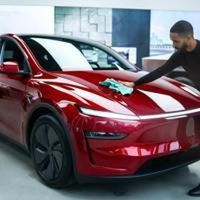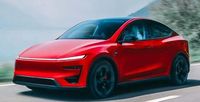Tesla, the trailblazer of the electric vehicle (EV) revolution, has once again made headlines—this time by unveiling cheaper versions of its flagship Model 3 sedan and Model Y SUV. The announcement, made on October 7, 2025, marks Tesla’s most recent effort to revive sagging sales and defend its market share in a global EV arena that’s more crowded and competitive than ever before.
The new Standard trims are priced at $36,990 for the Model 3 and $39,990 for the Model Y, according to Invezz. While these price tags are lower than existing versions, they still leave Tesla’s offerings firmly in the mid-premium segment—a fact not lost on industry analysts and would-be buyers alike. Tesla’s shares took a hit in response, slipping 4.2% in afternoon trading after the news broke, as investors weighed the impact of thinner profit margins against the potential for higher sales volumes.
Elon Musk, Tesla’s outspoken CEO, has long championed affordability as the key to unlocking Tesla’s next phase of growth. "The desire to buy the car is very high," Musk said during the company’s second-quarter earnings call in July 2025, but he acknowledged that price remains a stubborn barrier. "The more affordable we can make the car, the better." For years, Musk has teased the idea of a truly mass-market Tesla—at one point even floating the prospect of a $25,000 EV. Yet, that plan was quietly shelved last year, and the company’s latest move, while notable, falls short of breaking the critical $30,000 price threshold that many analysts believe is necessary to capture the mainstream market.
So what exactly do buyers get for these new, lower prices? According to Invezz and FYI, the Standard versions of the Model 3 and Model Y offer a solid driving range of about 321 miles (516 kilometers) on a single charge. However, the cost savings come with trade-offs: Tesla has stripped out several premium features to keep prices down. Gone are the rear heated seats, the LED lightbar in the Model Y, and the Autosteer driver assistance system. The new trims also feature smaller batteries, manually adjusted mirrors, and textile seats (with vegan leather available as an upgrade for the Model 3). Deliveries are slated to begin between December 2025 and January 2026, and the models are already available for order online.
Yet, the timing of the price drop is as significant as the move itself. The U.S. federal EV tax credit, which had provided buyers with a $7,500 incentive, expired at the end of September. That expiration led to a flurry of Tesla deliveries as customers rushed to beat the deadline, but it also means that, for many, the new "cheaper" Teslas are effectively more expensive than last month’s models. Dan Ives of Wedbush expressed disappointment, saying the price drop was "so limited," and other analysts echoed his concerns, arguing that the $5,000 cut compared to existing trims may not be enough to sway cost-conscious buyers now that the tax credit is gone.
Market strategists are skeptical that this pricing maneuver alone will be enough to reignite Tesla’s momentum. Shay Boloor, chief market strategist at Futurum Equities, described the move as "a pricing lever and not much of a product catalyst." He added, "You’ll get some volume lift but mostly from buyers trading down from the premium trims." The fear is that, rather than expanding Tesla’s customer base, the lower-priced models may simply cannibalize sales of higher-end versions, shrinking the company’s margins without delivering the hoped-for surge in demand.
Competition is another formidable hurdle. Tesla’s rivals—especially in Europe and China—are not standing still. According to FYI, the European EV market is now teeming with affordable options, many priced well below $30,000, and more than 25 new models are expected to hit showrooms in 2026. Homegrown brands like BYD, Dacia, and Citroen are expanding their lineups with feature-rich, wallet-friendly cars, steadily eroding Tesla’s once-dominant position. In China, Tesla’s vehicles remain notably pricier than domestic favorites like BYD’s Yuan Plus, limiting the American automaker’s growth potential in the world’s largest EV market.
Analysts warn that unless Tesla or its competitors roll out truly groundbreaking innovations or genuine budget models, the battle for market share—and profits—will remain fierce and unpredictable. The price war, while good news for consumers, puts automakers’ margins under intense pressure. As FYI notes, Tesla’s grip on Europe has loosened since 2023, and the company’s comeback prospects look "limited" without fresh, standout models.
There’s also the matter of brand perception. In Europe, Tesla’s image has taken a hit, not just from the lack of new models but also from controversies surrounding Musk himself. Meanwhile, in the U.S., the loss of the federal tax credit has made the new Teslas less attractive, and in China, the pricing gap with local competitors continues to be a stumbling block.
For Tesla, the stakes are high. Musk’s ambitious $1 trillion pay plan is tied to the company reaching significant operational and valuation milestones, including the delivery of 20 million vehicles over the next decade. Achieving such lofty goals will almost certainly require more than a pricing tweak—it will demand genuine innovation and a willingness to compete in the true mass-market segment.
In the meantime, Musk is steering Tesla’s long-term strategy toward new frontiers: artificial intelligence, robotaxis, and humanoid robots. While these ventures could shape the company’s future, Tesla’s near-term fortunes still hinge on selling cars—and lots of them. As Michael Ashley Schulman, CIO of Running Point, colorfully put it, Tesla is "dropping its Steve Jobs turtleneck and slipping into a Walmart hoodie." It’s an apt metaphor for a company trying to stay relevant and accessible in a market that’s moving faster and getting more crowded by the day.
Ultimately, the launch of cheaper Model 3 and Model Y trims is a calculated gamble—a bid to keep existing customers loyal and win back some ground from increasingly aggressive competitors. Whether it’s enough to deliver a true comeback or just a temporary boost remains to be seen. What’s clear is that the global EV race is entering a new, more turbulent phase, and Tesla will have to do more than just lower prices if it wants to stay ahead of the pack.
For now, buyers have more choices than ever, and the road ahead for Tesla—and the entire EV industry—looks anything but smooth.



